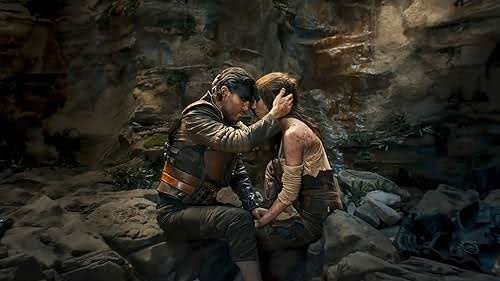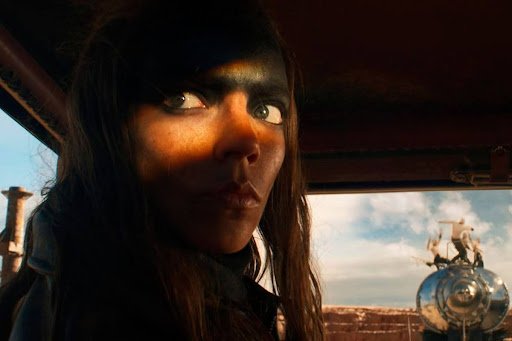Furiosa: The (Fury) Road Less Travelled
FURIOSA: A MAD MAX SAGA (GEORGE MILLER) 2024
🔥🔥🔥🔥 and a half
Cinema isn’t dead, though cinema as we know it might be dying before our eyes. Furiosa isn’t the movie to save it, through no fault of its own. It’s an epic saga in every sense - a wasteland tale full of rich textures and characters, of the expansive and the intimate. If it had been a first entry into the world of post-apocalyptic Australia, things might have been different. If it hadn’t followed Mad Max: Fury Road things would almost certainly be different. But lost in all the talk of opening weekends and total budgets, George Miller has crafted his most rounded Mad Max tale to date. And it’s not even close.
The Mad Max movies have never really been story-driven. The leap in societal breakdown between the 1979 original and its Road Warrior sequel is never fully explained. In 2015, following a 30-year hiatus, George Miller simply dropped the audience into this strange world of oil, grease and unending dust again, with exposition barely offered through snatches of audio over the opening titles and the briefest of introductory voiceovers from our titular protagonist who, it turned out, was not the main focus. If you knew who Max Rockatansky was, great; if you didn’t, ‘no worries, mate’, as they might say in Oz. To date, a close look at the characters and their backstory has felt broadly irrelevant, particularly in Fury Road, one of the purest action movies ever made. The irony here is, in making a much more rounded movie, Miller has diluted some of that purity. For those seduced by the insane set-pieces of its predecessor, this might feel like a retrograde step. The pace is less urgent, less desperate. Indeed it’s the longest of the stories to date; a true saga spanning years, not days, hours, minutes. It is patient and measured, not frantic, and that takes some adjustment.
This is not to say the movie is sluggish, merely that it’s not hitting that redline almost constantly. Sometimes Miller sticks with just that one V8, while judiciously deciding when to hook up the second one. It’s a brave move considering the foundations on which the critical and (relative) box office success of its predecessor were built. It takes the characters from being a mere idea to being something much deeper. The problem, if there is one, is that if you’re not already invested in this world, why would you want this deep dive into the people, the lore, and even the economy and the politics of it? Part of this is the general issue with prequels. They have to make sense in terms of what follows chronologically whilst also not dismantling what you like about the story and the characters. Personally, I think Miller has met both criteria. But liking a character and wanting to see more of them is not necessarily the same as being interested in their life-story.
The movie takes us from Furiosa’s abduction from the mythical Green Place that existed before the events of Fury Road. She first becomes the property of Dr Dementus (Chris Hemsworth), whose role in shaping her life is enormous, and then part of a business deal between Dementus and Immortan Joe, the villain from the 2015 movie. Ayla Browne, who plays Young Furiosa, is really very good here. So is Charlee Fraser, who plays her mother Mary, who mounts a desperate attempt to rescue her daughter while also protecting the secret of the Green Place and the Vuvalini who live there. They make an instant impression on the audience and the strength of their bond is clear from the outset. This opening sequence, the first of five chapters the movie is divided into, emphasising the saga aspect, introduces a young, determined Furiosa, with spirit and defiance and we are able to see how that grows throughout her journey.
Mary is an example of what Miller does so well. He introduces characters with little to no dialogue and immediately makes us connect with them. His brand of visual story-telling, where actions matter more than words, really is very special and for me, far more successful than that achieved by Denis Villeneuve in Dune: Part Two, for example. In Fury Road he did this with Charlize Theron as the older Furiosa and, to an only-slightly-lesser extent, Nicholas Hoult as Nux, whose own journey and story arc is equally important to Fury Road. Even though he always had bigger plans for the character of Furiosa, he still managed to establish her front and centre in viewers’ minds through spare, efficient storytelling.
For those turning up expecting to see Anya Taylor-Joy throughout the movie, there may be some disappointment too, but that is to do a disservice to Ayla Browne who strikes all the right notes as young Furiosa, particularly given the lack of dialogue she has to work with and, for me, these scenes are no less engaging. But as well as showing how Furiosa’s own life is shaped by her early experiences, the first two chapters establish much about the nature of the Wasteland and its economy where water, bullets and, above all, guzzoline are the keys to power as well as (relative) wealth. The movie shows how fragile that ecosystem is and how greed and ambition can easily upset the delicate balance, leading to violence and war. We see Furiosa, her spirit not contained nor her need for vengeance quelled, find a way to plot her escape, at which point the movie fires up that second V8 and switches into high gear, transitioning from Browne to Taylor-Joy through some really clever, largely-imperceptible CGI that facially ages and morphs one actress into the other.
What follows is what most viewers will have come to see - an epic set piece of an attack on a war-rig convoy, its shining chrome mirroring the baking desert. What’s most impressive is that Miller still finds ways to keep this fresh despite the basic convoy attack components being present in all but the first of the Mad Max films. Top-notch editing, inventive camera angles and moves, changes of perspective and mostly seamless CGI make this an absolute triumph, if anything even slicker than before. Certainly, the exaggerated effects of speed-cranking are gone. There’s a robust physicality where we feel and hear steel and chrome being torn apart, bullets zing off metal, bones crunch and bodies are ripped apart by explosions. But there’s more too, a new level of inventiveness, allowing this sequence to stand out from those that preceded it and against which it will be compared. Miller balances placing us in the heart of the action with locating the characters and capturing their reactions through his trademark intense closeups. I can’t imagine the storyboards for this because there is so much happening, yet we never lose sight of any of it. The shoot for this sequence alone took 78 days. That doesn’t surprise me, It’s worth the price of admission alone.
It is here where the Imperator Furiosa we know is truly born and where we are properly introduced to another of those characters that make a huge impact through their actions rather than words - Praetorian Jack played by Tom Burke. He serves as a mentor for Furiosa, teaching her the skills she will need to one day break free and find her way home. Their scenes together are the heart of the movie, and the start of Furiosa focusing on other lives to save. Burke offers a huge amount in the role and feels immediately at home in this world. It’s easy to see his influence on Furiosa’s character in Fury Road.
A lot has been made of the amount of dialogue Anya Taylor-Joy has to work with in the movie, but that is to again miss the point that, even in a story-driven movie such as this, actions not words are the key to the narrative. Clearly it represents a challenge to any actor, but it’s hard to argue that she is not up to that challenge. Taylor-Joy conveys a single-minded ferocity and determination, almost entirely through her eyes, which stand out expressively against the grease smeared on her face and the sun-baked dust in every crease of her skin. She offers a lithe physicality in combat. She embodies the spirit of a warrior, single-minded and focussed but increasingly adaptive. As big a fan of hers as I was heading in, I was sceptical of her casting, but she occupies this space perfectly.
What then, of our last star, Chris Hemsworth? He certainly gets to have the most fun as the increasingly unhinged Dementus, and the most lines. He’s an insane Shakespearean character that embodies the feudal, anarchic nature of the Wasteland. Yet there is still some subtlety there and surprising range, sometimes even a softness though that is merely a mask for manipulation and self-interest. He’s happy for the world to burn as long as he comes out on top. Hemsworth is well suited to the role, offering the necessary physical stature but also an over-the-top quality to the acting. The role doesn’t require sophistication - will, rather than words, is ultimately the key - though he still gets the best dialogue.
Elsewhere, smaller roles add further character to Miller’s world and we learn more about Immortan Joe and his entourage and offspring, as well as getting our very own mini-me warboy. There is such rich texture here, it still feels like Miller is barely scratching the surface. Once more the production’s design is glorious, particularly the pristine virgin war rig and the costuming, and there’s no dropoff in cinematography with the move from John Seale to Simon Duggan. One area where things have noticeably improved over the last 9 years is the integration of visual effects, offering a seamless reality, rather than an exaggerated hyper-reality. If anything, that makes the story more real, emphasising the nature of this instalment.
Many great films were considered box office flops. While we won’t be able to tally up the final results for some time, if that is the final fate of Furiosa it’s a real shame but should not diminish it. It still hit Number 1 on release, something no preceding Mad Max movie has achieved, and it’s not the only high profile movie to be affected by what is happening in cinema at the moment. There will be those who simply want more of the non-stop action spectacle of its predecessor, but for me, this shift in viewpoint is entirely successful. What’s more, the standout action sequence here exceeds in quality the quantity in Fury Road. This, and the epic sweep of the tale means it should be seen on the biggest screen possible. Would you be mad if you missed out on seeing this at the cinema? I would be furious.






